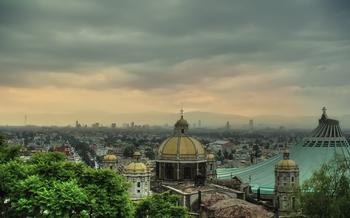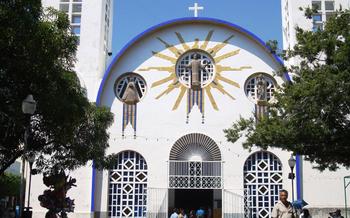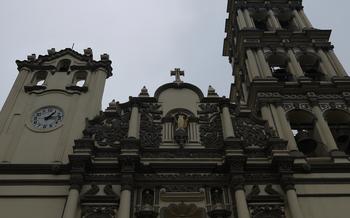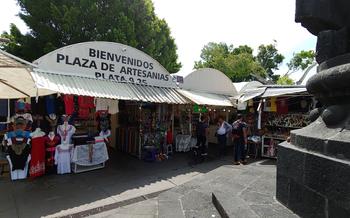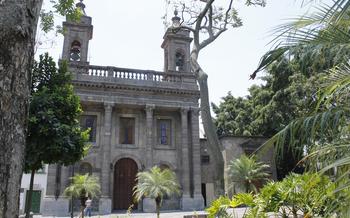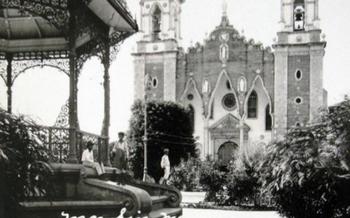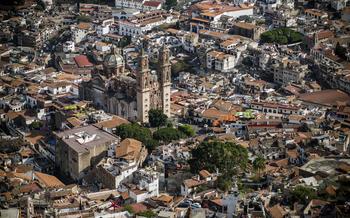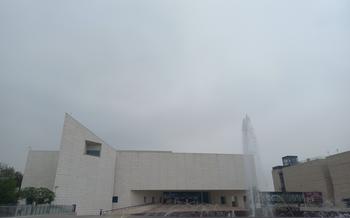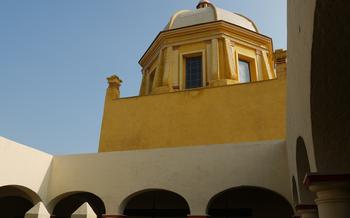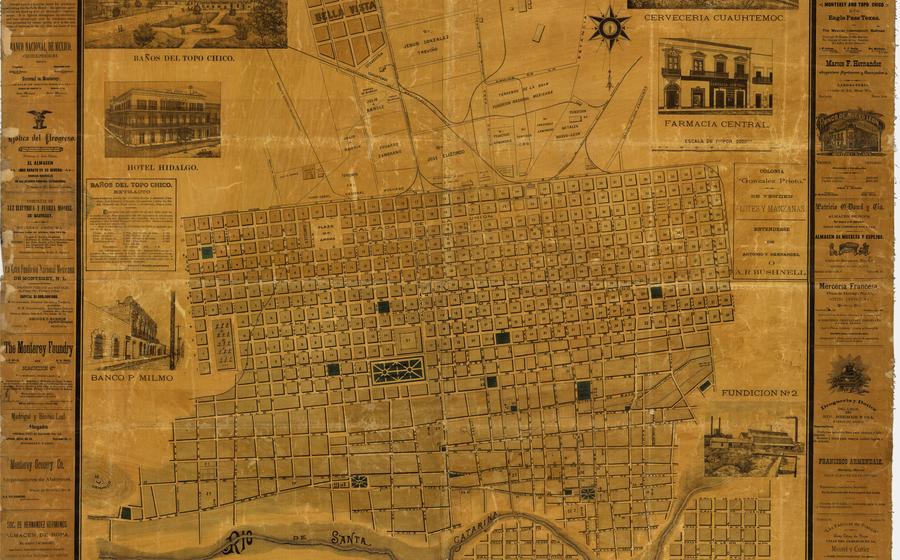
Catedral de Nuestra Señora del Roble
- The Catedral de Nuestra Señora del Roble: A Majestic Landmark in Monterrey
- Exploring the Cathedral's Exterior
- Step Inside the Cathedral: An Inspiring Sanctuary
- History and Construction of the Cathedral
- 1 Origins and Evolution of the Design
- 2 Challenges and Triumphs during Construction
- 3 Role of Renowned Architects and Artisans
- 4 Significance as a Historical Landmark
- Pilgrimage and Religious Celebrations
- The Cathedral's Museum: A Treasure Trove of History
- The Sanctuary of Our Lady of the Oak
- Architecture and Design Elements
- Visiting the Cathedral: Tips for a Rewarding Experience
- Unveiling the Cathedral's Secrets
- Inspiring Art and Craftsmanship
- Insider Tip: A Unique Perspective
The Catedral de Nuestra Señora del Roble: A Majestic Landmark in Monterrey
The Catedral de Nuestra Señora del Roble, also known as Monterrey Cathedral, is, making it one of the oldest cathedrals in Mexico and a significant landmark in the city of Monterrey, the capital of the northeastern state of Nuevo León. The cathedral's architectural style is an eclectic fusion of Gothic, Baroque, and Neoclassical elements, reflecting the diverse influences that have shaped Monterrey's cultural heritage.
As a symbol of the Catholic faith, the cathedral holds a profound religious significance for the people of Monterrey. It serves as the seat of the Archdiocese of Monterrey and is a popular pilgrimage site for devotees from across the region. The cathedral's grand interior, adorned with intricate altars, stunning stained-glass windows, and sacred artwork, creates an atmosphere of reverence and spirituality that draws visitors from all walks of life.
Throughout its existence, the cathedral has witnessed countless historical events and played a crucial role in the community's religious and social life. It has undergone several renovations and expansions, each adding to its architectural grandeur and historical significance. The cathedral's rich collection of religious artifacts, artwork, and relics, housed in its onsite museum, offers visitors a glimpse into the history of the Catholic Church in Monterrey and the deep devotion of its people.
Practical Information:
-
Location: The cathedral is situated in the heart of Monterrey's historic center, at the intersection of Zuazua and 5 de Mayo streets.
-
Hours: The cathedral is open to the public daily from 7:00 AM to 7:00 PM. Mass schedules vary, so it's advisable to check with the parish office for specific timings.
-
Admission: Entrance to the cathedral is free of charge, but donations are welcome. The museum may have a separate admission fee.
Exploring the Cathedral's Exterior
The Catedral de Nuestra Señora del Roble boasts a captivating façade that showcases the fusion of Gothic, Baroque, and Neoclassical architectural styles. Its intricately carved stonework, sculptures, and ornaments adorn the exterior, narrating the history and significance of the cathedral.
The main entrance features an impressive arched portal, flanked by two majestic bell towers that rise above the city skyline. The towers, adorned with intricate carvings and spires, serve as a symbol of the cathedral's grandeur and religious importance.
Above the portal, a large rose window commands attention, its vibrant stained-glass panes depicting biblical scenes and figures. The intricate details of the carvings and sculptures throughout the façade symbolize the cathedral's dedication to the Virgin Mary and reflect the artistic traditions of the region.
The surrounding plaza, known as the Macroplaza, holds historical significance as the heart of Monterrey. It offers a picturesque setting for visitors to admire the cathedral's imposing presence and appreciate its architectural beauty from various angles.
Step Inside the Cathedral: An Inspiring Sanctuary
As you cross the threshold of the Catedral de Nuestra Señora del Roble, a sense of awe and tranquility envelops you. The interior of the cathedral is a testament to the grandeur and artistry that went into its creation. The soaring ceilings, supported by intricate columns, create a sense of vastness and majesty. The walls are adorned with stunning stained-glass windows, casting a kaleidoscope of colors onto the marble floors. The intricate altars, with their gold leaf embellishments and religious iconography, are a testament to the devotion and craftsmanship of the artisans who created them. The peaceful ambiance and atmosphere of reverence invite contemplation and reflection, making the cathedral a sanctuary for both the faithful and visitors seeking a moment of tranquility amidst the vibrant city.
History and Construction of the Cathedral
1 Origins and Evolution of the Design
The Catedral de Nuestra Señora del Roble's origins can be traced back to the 16th century when a small chapel was erected on the site. As Monterrey grew in importance, the need for a larger and more impressive cathedral arose, leading to the construction of the current structure in the 18th century. The cathedral's design underwent several modifications and expansions over the years, blending various architectural styles and reflecting the changing tastes and influences of the time.
2 Challenges and Triumphs during Construction
The construction of the cathedral was not without its challenges. The builders had to overcome the limitations of the terrain, as the site was prone to flooding from the nearby river. They also faced financial constraints and had to rely on donations from the community to complete the project. Despite these obstacles, the cathedral was eventually completed in 1790, standing as a testament to the perseverance and dedication of its builders.
3 Role of Renowned Architects and Artisans
The construction of the Catedral de Nuestra Señora del Roble involved the collaboration of skilled architects and artisans. The cathedral's design is attributed to the renowned architect José de la Cruz, who blended Gothic, Baroque, and Neoclassical elements to create a unique and harmonious style. The intricate carvings and sculptures adorning the cathedral's interior and exterior were crafted by talented local artisans, contributing to the cathedral's rich artistic heritage.
4 Significance as a Historical Landmark
The Catedral de Nuestra Señora del Roble stands as a significant historical landmark in Monterrey. It has witnessed the city's transformation over the centuries and has played a pivotal role in shaping its cultural and religious identity. The cathedral is a testament to the enduring faith and devotion of the people of Monterrey and is a source of pride for the community.
Pilgrimage and Religious Celebrations
The Catedral de Nuestra Señora del Roble is a significant pilgrimage site for Catholics in Mexico and beyond. Devotees from across the country flock to the cathedral to pay homage to Our Lady of the Oak, the patron saint of Monterrey. The annual feast day celebration, held on December 12, is a grand occasion that attracts thousands of pilgrims. The festivities include colorful processions, traditional dances, and heartfelt prayers.
During Lent, the cathedral hosts special services and penitential processions, drawing large crowds seeking spiritual renewal. The Holy Week leading up to Easter is observed with solemn ceremonies and reenactments of the Passion of Christ, culminating in the Easter Vigil and Resurrection Sunday celebrations.
Throughout the year, the cathedral also holds various religious festivals and events, such as the Feast of the Immaculate Conception, the Feast of Corpus Christi, and the Day of the Dead. Each celebration is unique, showcasing the rich traditions and devotion of the Catholic community in Monterrey.
Attending these religious gatherings is a deeply immersive experience, allowing visitors to witness the vibrant faith and cultural expressions of the local people. The cathedral's sacred atmosphere and the fervor of the devotees create a powerful sense of spirituality and connection to the divine.
The Cathedral's Museum: A Treasure Trove of History
The Catedral de Nuestra Señora del Roble houses a remarkable museum that offers a fascinating glimpse into the history of the Catholic Church in Monterrey and beyond. This treasure trove of religious artifacts and artwork provides visitors with a deeper understanding of the spiritual heritage of the region.
Among the highlights of the museum's collection are exquisite vestments, sacred objects, and relics that have been meticulously preserved over the centuries. Each item holds a story, revealing the devotion and craftsmanship of generations past. Visitors can admire intricate gold and silver chalices, ornate monstrances, and finely embroidered liturgical garments that were once worn by priests and bishops during religious ceremonies.
The museum also showcases a collection of paintings, sculptures, and other works of art that depict religious scenes and figures. These artworks not only enhance the beauty of the cathedral but also serve as a testament to the artistic talents of local and international artists who have contributed to its rich cultural legacy.
Through interactive exhibits and informative displays, the museum educates visitors about the history of the Catholic Church in Monterrey and the role that the cathedral has played in shaping the city's religious and cultural identity. It is a must-visit destination for anyone interested in exploring the spiritual heritage of this vibrant region.
The Sanctuary of Our Lady of the Oak
At the heart of the Catedral de Nuestra Señora del Roble lies a sacred sanctuary dedicated to Our Lady of the Oak, the patron saint of Monterrey. Legend has it that in the 17th century, a humble shepherdess named Inés de la Cruz discovered a miraculous image of the Virgin Mary carved onto the trunk of an oak tree. This discovery sparked a deep devotion among the faithful, and the image eventually found its home within the cathedral.
The Sanctuary of Our Lady of the Oak is a place of profound spiritual significance for Catholics in Monterrey. The miraculous image of the Virgin Mary, adorned with precious jewels and elaborate garments, is a symbol of hope, faith, and divine protection. Devotees from all walks of life flock to the sanctuary to pray, offer their petitions, and seek solace in the presence of their beloved patroness.
Each year, on December 8th, the cathedral celebrates the feast day of Our Lady of the Oak with great fervor and devotion. Thousands of pilgrims gather to honor the Virgin Mary and participate in a grand procession that winds its way through the streets of Monterrey. The air is filled with music, prayers, and the scent of incense as the faithful express their gratitude and seek her blessings.
The Sanctuary of Our Lady of the Oak is not just a place of worship but also a repository of cultural and historical treasures. The walls are adorned with intricate murals depicting scenes from the life of the Virgin Mary, while the altar features elaborate carvings and sculptures that tell the story of her miraculous interventions. The sanctuary is a testament to the deep faith and devotion of the people of Monterrey and a reminder of the enduring power of religious traditions in Mexican culture.
Architecture and Design Elements
The Catedral de Nuestra Señora del Roble showcases a remarkable blend of architectural styles, reflecting different periods and influences. Gothic elements are evident in the pointed arches, ribbed vaults, and flying buttresses, which lend an air of grandeur and majesty to the structure. Baroque influences are seen in the elaborate ornamentation, intricate carvings, and the use of opulent materials such as gold leaf and marble. The Neoclassical style is apparent in the symmetry, order, and simplicity of certain elements, particularly in the façade and the interior layout.
The intricate details of the stone carvings and sculptures that adorn the cathedral's exterior and interior are particularly noteworthy. These intricate works of art depict religious figures, biblical scenes, and symbolic motifs, adding depth and meaning to the overall design. The symbolism and meaning behind the architectural elements are carefully considered, with each detail serving to convey a specific message or narrative.
The fusion of architectural styles in the Catedral de Nuestra Señora del Roble is a testament to the skill and creativity of the architects and artisans who worked on its construction. It reflects the evolution of architectural trends over time and highlights the unique character of this iconic landmark.
Visiting the Cathedral: Tips for a Rewarding Experience
To fully appreciate the grandeur of the Catedral de Nuestra Señora del Roble, it's important to observe proper etiquette and make the most of your visit. Dress respectfully, covering your shoulders and knees, and maintain a quiet and reverent demeanor within the cathedral. Guided tours are available for a deeper understanding of the cathedral's history and significance, while self-guided exploration allows for a more personal and contemplative experience. Photography is permitted, but be mindful of others and avoid using flash or tripods. To avoid crowds and ensure a peaceful visit, plan your visit during weekdays or early mornings. Attending a mass or religious service is an enriching way to witness the cathedral's spiritual significance firsthand.
Unveiling the Cathedral's Secrets
Beyond its majestic façade and awe-inspiring interior, the Catedral de Nuestra Señora del Roble holds a treasure trove of hidden stories and intriguing legends. One captivating tale speaks of a secret underground tunnel that once connected the cathedral to the nearby Obispado Palace, providing a clandestine passage for priests and religious figures during times of unrest.
During restoration work in the 1990s, workers stumbled upon a mysterious crypt beneath the cathedral, containing the remains of several individuals, including a young woman believed to be a nun. The discovery sparked speculation about the lives and secrets of those interred within the cathedral's hallowed grounds.
Another intriguing legend revolves around the cathedral's bells, which are said to possess a unique and haunting sound. Locals claim that on certain nights, the bells can be heard tolling on their own, creating an eerie and otherworldly atmosphere around the cathedral.
These stories and legends add an enchanting layer of mystery to the Catedral de Nuestra Señora del Roble, inviting visitors to delve deeper into its rich history and uncover its hidden secrets.
Inspiring Art and Craftsmanship
The Catedral de Nuestra Señora del Roble is a testament to the masterful craftsmanship and artistry that went into its creation. The intricate stained-glass windows depict biblical scenes and religious figures with vibrant colors and exquisite detail. Each window tells a story, adding to the overall narrative of the cathedral's interior. The intricate carvings and sculptures that adorn the walls, columns, and altars showcase the skill and devotion of the artisans who created them. The unique blend of artistic styles and influences, from Gothic to Baroque to Neoclassical, creates a visually stunning and harmonious space. The symbolism and messages conveyed through the artwork, from the crucifixion of Christ to the glorification of the Virgin Mary, add depth and meaning to the cathedral's spiritual significance.
Insider Tip: A Unique Perspective
To fully appreciate the grandeur and beauty of the Catedral de Nuestra Señora del Roble, make sure to explore the surrounding area. For a unique perspective, climb to the top of the nearby Cerro de la Silla, the iconic mountain that overlooks Monterrey. From this vantage point, you can capture breathtaking panoramic views of the city, with the cathedral standing as a majestic centerpiece. Don't miss the opportunity to soak in the stunning sunrise or sunset hues that illuminate the cathedral's façade, creating a truly magical scene.
After your visit to the cathedral, take some time to explore the charming Barrio Antiguo neighborhood, located just a short walk away. This historic district boasts cobblestone streets, colorful buildings, and a vibrant atmosphere. Indulge in the local cuisine at one of the many traditional Mexican restaurants or cafes, and immerse yourself in the rich culture of Monterrey. To fully embrace the local experience, consider attending a traditional Mexican mass at the cathedral. This is an excellent opportunity to witness the deep devotion and spirituality of the local community.
